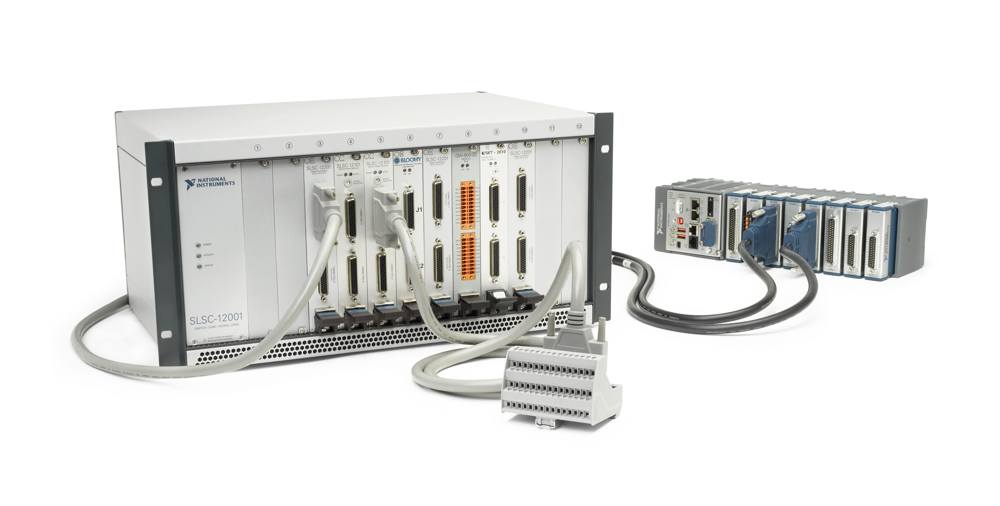Mitigating risk in test system upgrades

National Instruments’ senior technical marketing engineer, Jeremy Twaits looks at the ways of accelerating the process of building an aerospace LRU test system, allowing engineers to focus their expertise on producing optimised products.
Aerospace programme cycles determine the lifecycles and operation of line-replaceable unit (LRU) test systems. Many aerospace LRU testers are still in service because programmes didn’t include the budget or time to update and extend the capability of deployed systems. Proposing changes to the status quo solution can be difficult, since programmes must balance the time and cost of making alterations against the benefits of implementing new test capabilities. This leads to decades-old test systems with insufficient technology updates still in operation.
Across the aerospace industry, deferring test infrastructure upgrades results in the accumulation of technical risk. Each deferment increases the cost and risk associated with an upgrade on a subsequent programme. This lack of technological readiness can limit an aerospace programme’s options for meeting its test and quality requirements and can hinder its ability to be innovative and competitive.
Test architecture inner workings
Programme officers are primarily concerned with meeting customer requirements and preventing quality escapes, rather than focusing on the inner workings of their test architecture. At the enterprise level, quality test involves better model-based design, greater test automation, common architectures between lifecycle phases, and improved requirements tracking. However, process improvements typically require modernisation of the underlying test infrastructure, so they are often sacrificed to complete the programme’s basic elements, in order to meet demanding schedules.

To ensure enduring product quality, a test architecture needs to be flexible enough to allow for continuous evolution from programme to programme. Paradoxically, the migration to this type of architecture must occur within a single programme, since capital budgets outside of a programme are rare. Any path forward requires a clear understanding of a programme’s primary cost, risk and schedule drivers. Factors like designing the test system, establishing point-to-point wiring and building test adapters are essential to creating a functioning test system, but they don’t necessarily contribute immediately and directly to increased product quality.
Hardware typically accounts for less than a quarter of the total cost of test, while labour for designing and building systems accounts for the greatest impact upon budget and schedule. Different companies’ LRU test systems often have large technology overlaps. Commercial off-the-shelf (COTS) components can address many of these system commonalities, enabling engineers to focus time and effort on niche aspects specific to their units under test.
LRU test system commonality
A basic LRU test system consists of a unit under test (UUT) interfaced to a mass interconnect, connected to simulation I/O that is driven by a test executive that runs the aircraft simulation. This basic setup is customised by adding signal conditioning for sensor simulation, and specific loads to be driven by the LRU. Fault insertion can be added for software testing, and real devices are added to be controlled by the LRUs in integration testing. Switches are added to toggle between real and simulated versions of devices. Additional customisations can involve a breakout box for manual faulting, signal injection and rerouting, and sense lines to know exactly what the LRU is seeing during all test phases. For sense lines, instrument-grade measurement equipment may be needed.
Every LRU test system uses some variation of this basic setup, yet many companies create significant amounts of custom design and wiring. In some cases, this may be an acceptable cost of business, but alternative connectivity methods could save time and money.
Saab Aeronautics needed a commercial off-the-shelf solution to replace its custom system for interfacing with Gripen aircraft LRUs in simulators. These simulators allow Saab to test LRUs such as flight control systems, tactical systems, sensors and other avionics equipment, without putting a fighter in the sky, which could be costly or even dangerous.
Saab selected National Instruments’ switch, load and signal conditioning (SLSC) add-on for the PXI and CompactRIO measurement platforms as the basis for its LRU test system. SLSC allows engineers to transform and manipulate standard analogue and digital signal paths, to implement the inline functions that form the core of an LRU validation architecture. To help to eliminate the need for customisation, modules are available for the most common signal types, including high-voltage digital waveform signals, resistive sensor simulation and ARINC 429 and MIL-STD-1553 PXI interface modules.
“The SLSC system looked interesting and similar to the one we were developing internally,” explains Saab Aeronautics’ Anders Tunströmer. “It also made creating the system easier for us as NI is a preferred supplier for Saab already. By having NI define the ecosystem for switches, loads, and signal conditioning, we could potentially lower costs as we would not need to spend time and effort defining them ourselves.”

Saab was able to choose between modules from not only NI, but also NI’s Alliance Partners, including Bloomy Controls and SET. They even worked with a local developer, Syncore Technologies, to create custom modules where needed.
“We can use the SLSC system to focus on developing custom circuitry to save time and development resources,” states Tunströmer. “Without the SLSC, we may have needed to spend thousands of man hours and many thousands of Euros in materials to develop the system ourselves. Having a COTS product means we can contain development and maintenance costs promoting the Saab initiative to break the cost curve.”
Reducing the time and cost of developing and upgrading test systems will clearly reduce the inherent risk of technology updates, making it easier to prioritise upgrades within programme cycles. Utilising COTS components rather than custom design can: reduce cost per I/O pin; simplify cabling; off-load maintenance burdens; and shorten development timelines.
The goal is to allow engineers to focus their expertise on optimising products, not on developing custom test equipment, a point summarised by Tunströmer: “Using the SLSC system further promotes our goal to focus the attention on building HIL test systems and rigs, not developing advanced hardware.”











